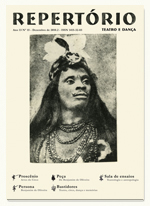<b>MOVIMENTOS DE DANÇA E LITERATURA: SALOMÉ E A CABEÇA DE JOÃO BATISTA NO RELATO DE MARCOS</b> <br> [Enéias Farias Tavares (UFSM)] <br> [Juliana de Abreu Werner T. (UFRGS)]
DOI :
https://doi.org/10.9771/r.v0i15.5223Résumé
A dança perpassa a história de todas as civilizações antigas. Na cultura primitiva, ela estabelece uma forma de comunicação única entre um povo e suas tradições. Essa comunicação ocorre por meio de um vocabulário próprio de movimentos e gestos corporais que também farão parte dos rituais religiosos. No caso dos textos judaicos, a dança está associada a comemorações bélicas, à conquista militar, à realização pessoal e ao culto à divindade, além de exemplificar um aspecto do “ritual pagão” dos povos não-judaicos. Por sua vez, o episódio envolvendo a filha de Herodias, Salomé, registrado nos evangelhos de Mateus e Marcos, foi relido nos séculos posteriores figurando sua dança apenas em associação com a licenciosidade romana. O objetivo desse texto é analisar a relação dos textos velho-testamentários com a dança e opô-la ao relato de Marcos, ressaltando o modo peculiar com que o autor constrói sua narrativa. Nesse sentido, buscamos uma aproximação entre o texto literário bíblico e as práticas da dança no contexto judaico e romano.Dance passes through the history of all ancient civilizations. In the culture of primitive society, it provides a unique form of communication between people and their traditions. This communication occurs through a specific vocabulary of movements and body gestures which is also part of religious rituals. In the case of Jewish texts, the dance is associated with the celebration of war, military conquest, personal accomplishment and to worship their god, besides its "pagan worship" nature in non-Jewish cultures. On the other hand, the story of the dance of Salome, in Matthew and Mark, was reread in later centuries fi guring dance only in association with the Roman licentiousness. The aim of this paper is to analyze the relationship of old-testamentary texts with dance and oppose them to Mark's account, highlighting the peculiar way in which the author described the dance, the setting and characters of the story. In this sense, we seek an approximation between biblical literary text and the practice of dance in a Jewish and Roman context.
Téléchargements
Les données relatives au téléchargement ne sont pas encore disponibles.
Téléchargements
Publiée
2010-07-07
Comment citer
Repertório, T. & D. (2010). <b>MOVIMENTOS DE DANÇA E LITERATURA: SALOMÉ E A CABEÇA DE JOÃO BATISTA NO RELATO DE MARCOS</b> <br> [Enéias Farias Tavares (UFSM)] <br> [Juliana de Abreu Werner T. (UFRGS)]. Repertório, (15), 176–186. https://doi.org/10.9771/r.v0i15.5223
Numéro
Rubrique
BASTIDORES
Licence
Os/as usuários/as poderão ler, baixar, copiar, distribuir, imprimir os textos integralmente desde que sejam claramente mencionadas as referências aos/às autores/as e à Revista Repertório. A utilização dos textos em outros modos depende da aprovação dos/as autores/as e deste periódico.
Os conteúdos emitidos em textos publicados são de responsabilidade exclusiva de seus/suas autores/as e não refletem necessariamente as opiniões da Revista Repertório.








